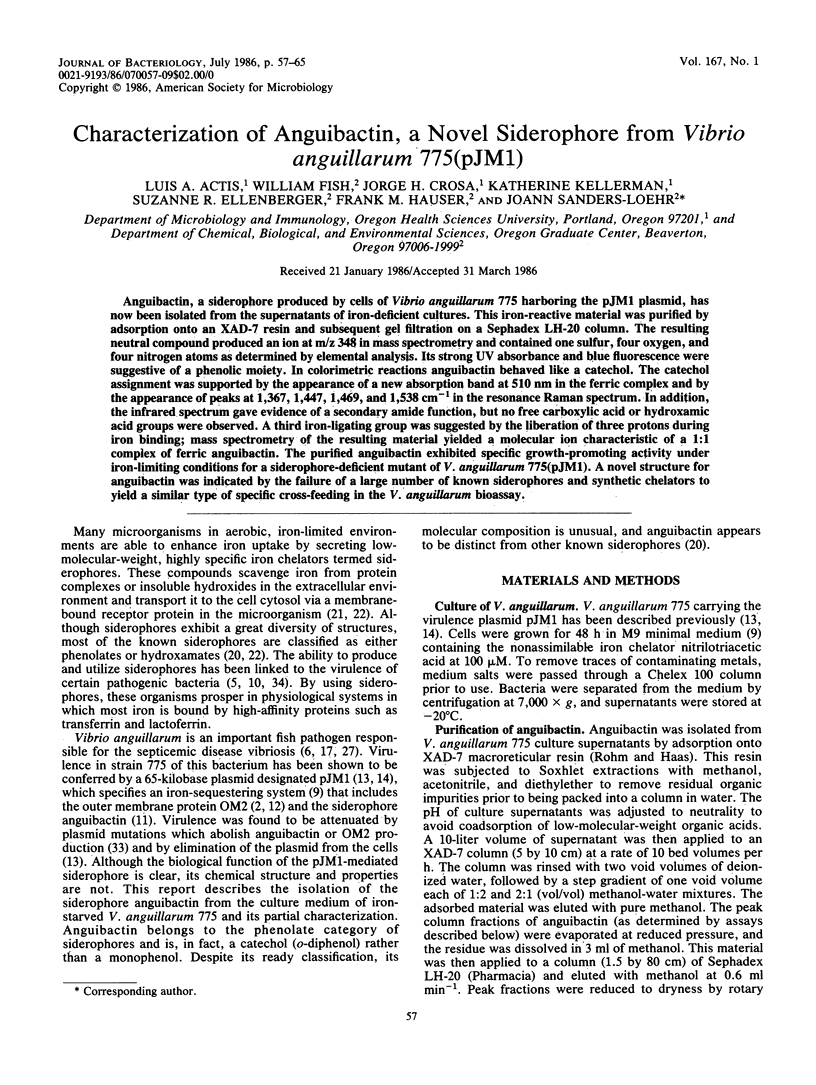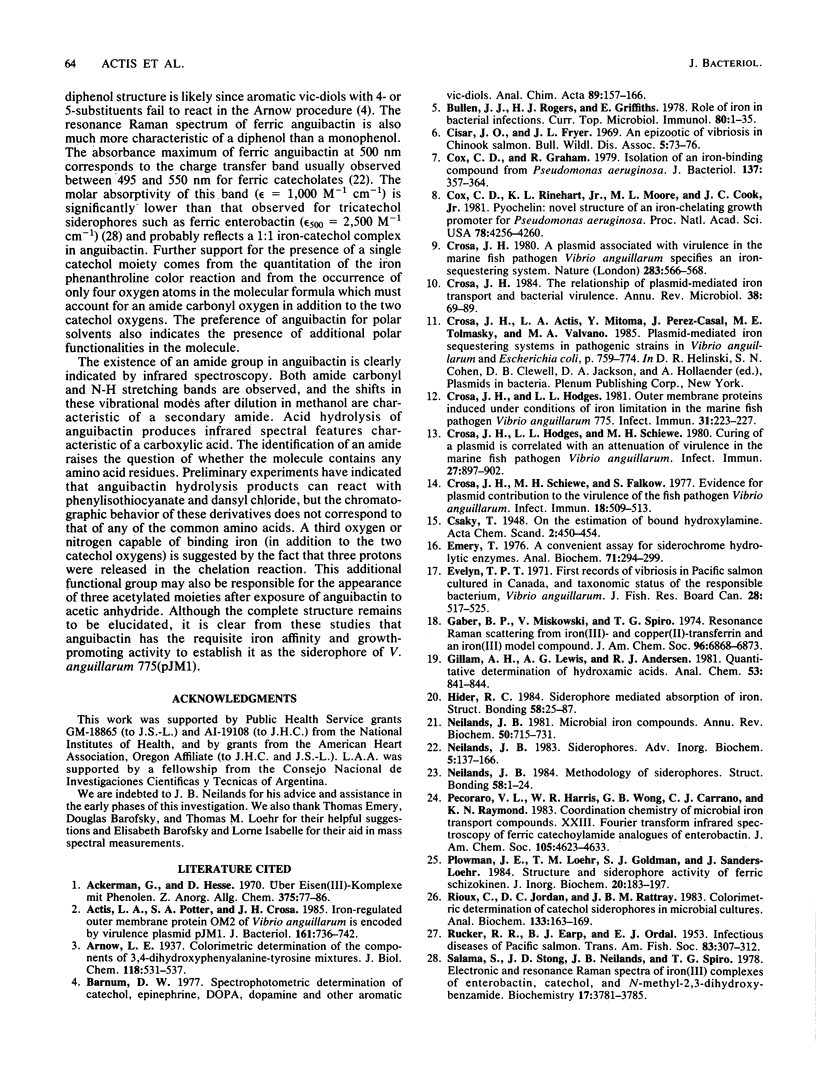Abstract
Anguibactin, a siderophore produced by cells of Vibrio anguillarum 775 harboring the pJM1 plasmid, has now been isolated from the supernatants of iron-deficient cultures. This iron-reactive material was purified by adsorption onto an XAD-7 resin and subsequent gel filtration on a Sephadex LH-20 column. The resulting neutral compound produced an ion at m/z 348 in mass spectrometry and contained one sulfur, four oxygen, and four nitrogen atoms as determined by elemental analysis. Its strong UV absorbance and blue fluorescence were suggestive of a phenolic moiety. In colorimetric reactions anguibactin behaved like a catechol. The catechol assignment was supported by the appearance of a new absorption band at 510 nm in the ferric complex and by the appearance of peaks at 1,367, 1,447, 1,469, and 1,538 cm-1 in the resonance Raman spectrum. In addition, the infrared spectrum gave evidence of a secondary amide function, but no free carboxylic acid or hydroxamic acid groups were observed. A third iron-ligating group was suggested by the liberation of three protons during iron binding; mass spectrometry of the resulting material yielded a molecular ion characteristic of a 1:1 complex of ferric anguibactin. The purified anguibactin exhibited specific growth-promoting activity under iron-limiting conditions for a siderophore-deficient mutant of V. anguillarum 775(pJM1). A novel structure for anguibactin was indicated by the failure of a large number of known siderophores and synthetic chelators to yield a similar type of specific cross-feeding in the V. anguillarum bioassay.
Full text
PDF








Selected References
These references are in PubMed. This may not be the complete list of references from this article.
- Actis L. A., Potter S. A., Crosa J. H. Iron-regulated outer membrane protein OM2 of Vibrio anguillarum is encoded by virulence plasmid pJM1. J Bacteriol. 1985 Feb;161(2):736–742. doi: 10.1128/jb.161.2.736-742.1985. [DOI] [PMC free article] [PubMed] [Google Scholar]
- Barnum D. W. Spectrophotometric determination of catechol, epinephrine, dopa, dopamine and other aromatic vic-diols. Anal Chim Acta. 1977 Mar;89(1):157–166. doi: 10.1016/S0003-2670(01)83081-6. [DOI] [PubMed] [Google Scholar]
- Bullen J. J., Rogers H. J., Griffiths E. Role of iron in bacterial infection. Curr Top Microbiol Immunol. 1978;80:1–35. doi: 10.1007/978-3-642-66956-9_1. [DOI] [PubMed] [Google Scholar]
- Cisar J. O., Fryer J. L. An epizootic of vibriosis in chinook salmon. Wildl Dis. 1969 Apr;5(2):73–76. doi: 10.7589/0090-3558-5.2.73. [DOI] [PubMed] [Google Scholar]
- Cox C. D., Graham R. Isolation of an iron-binding compound from Pseudomonas aeruginosa. J Bacteriol. 1979 Jan;137(1):357–364. doi: 10.1128/jb.137.1.357-364.1979. [DOI] [PMC free article] [PubMed] [Google Scholar]
- Cox C. D., Rinehart K. L., Jr, Moore M. L., Cook J. C., Jr Pyochelin: novel structure of an iron-chelating growth promoter for Pseudomonas aeruginosa. Proc Natl Acad Sci U S A. 1981 Jul;78(7):4256–4260. doi: 10.1073/pnas.78.7.4256. [DOI] [PMC free article] [PubMed] [Google Scholar]
- Crosa J. H. A plasmid associated with virulence in the marine fish pathogen Vibrio anguillarum specifies an iron-sequestering system. Nature. 1980 Apr 10;284(5756):566–568. doi: 10.1038/284566a0. [DOI] [PubMed] [Google Scholar]
- Crosa J. H., Actis L. A., Mitoma Y., Perez-Casal J., Tolmasky M. E., Valvano M. A. Plasmid-mediated iron sequestering systems in pathogenic strains of Vibrio anguillarum and Escherichia coli. Basic Life Sci. 1985;30:759–774. doi: 10.1007/978-1-4613-2447-8_52. [DOI] [PubMed] [Google Scholar]
- Crosa J. H., Hodges L. L. Outer membrane proteins induced under conditions of iron limitation in the marine fish pathogen Vibrio anguillarum 775. Infect Immun. 1981 Jan;31(1):223–227. doi: 10.1128/iai.31.1.223-227.1981. [DOI] [PMC free article] [PubMed] [Google Scholar]
- Crosa J. H., Hodges L. L., Schiewe M. H. Curing of a plasmid is correlated with an attenuation of virulence in the marine fish pathogen Vibrio anguillarum. Infect Immun. 1980 Mar;27(3):897–902. doi: 10.1128/iai.27.3.897-902.1980. [DOI] [PMC free article] [PubMed] [Google Scholar]
- Crosa J. H., Schiewe M. H., Falkow S. Evidence for plasmid contribution to the virulence of fish pathogen Vibrio anguillarum. Infect Immun. 1977 Nov;18(2):509–513. doi: 10.1128/iai.18.2.509-513.1977. [DOI] [PMC free article] [PubMed] [Google Scholar]
- Crosa J. H. The relationship of plasmid-mediated iron transport and bacterial virulence. Annu Rev Microbiol. 1984;38:69–89. doi: 10.1146/annurev.mi.38.100184.000441. [DOI] [PubMed] [Google Scholar]
- Emery T. A convenient assay for siderochrome hydrolytic enzymes. Anal Biochem. 1976 Mar;71(1):294–299. doi: 10.1016/0003-2697(76)90039-7. [DOI] [PubMed] [Google Scholar]
- Gaber B. P., Miskowski V., Spiro T. G. Resonance Raman scattering from iron(3)- and copper(II)-transferrin and an iron(3) model compound. A spectroscopic interpretation of the transferrin binding site. J Am Chem Soc. 1974 Oct 30;96(22):6868–6873. doi: 10.1021/ja00829a010. [DOI] [PubMed] [Google Scholar]
- Neilands J. B. Microbial iron compounds. Annu Rev Biochem. 1981;50:715–731. doi: 10.1146/annurev.bi.50.070181.003435. [DOI] [PubMed] [Google Scholar]
- Neilands J. B. Siderophores. Adv Inorg Biochem. 1983;5:137–166. [PubMed] [Google Scholar]
- Rioux C., Jordan D. C., Rattray J. B. Colorimetric determination of catechol siderophores in microbial cultures. Anal Biochem. 1983 Aug;133(1):163–169. doi: 10.1016/0003-2697(83)90238-5. [DOI] [PubMed] [Google Scholar]
- Salama S., Stong J. D., Neilands J. B., Spiro T. G. Electronic and resonance Raman spectra of iron(III) complexes of enterobactin, catechol, and N-methyl-2,3-dihydroxybenzamide. Biochemistry. 1978 Sep 5;17(18):3781–3785. doi: 10.1021/bi00611a017. [DOI] [PubMed] [Google Scholar]
- Sjöberg B. M., Loehr T. M., Sanders-Loehr J. Raman spectral evidence for a mu-oxo bridge in the binuclear iron center of ribonucleotide reductase. Biochemistry. 1982 Jan 5;21(1):96–102. doi: 10.1021/bi00530a017. [DOI] [PubMed] [Google Scholar]
- Walter M. A., Potter S. A., Crosa J. H. Iron uptake system medicated by Vibrio anguillarum plasmid pJM1. J Bacteriol. 1983 Nov;156(2):880–887. doi: 10.1128/jb.156.2.880-887.1983. [DOI] [PMC free article] [PubMed] [Google Scholar]
- Weinberg E. D. Iron withholding: a defense against infection and neoplasia. Physiol Rev. 1984 Jan;64(1):65–102. doi: 10.1152/physrev.1984.64.1.65. [DOI] [PubMed] [Google Scholar]


